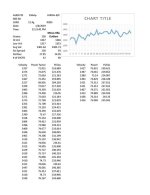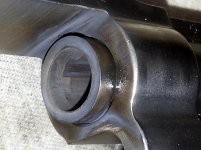Frame stretch can (among other factors) contribute to increased b-c gap and endshake, but generally the issue is the yoke barrel compacting with use and the corrective is stretching it; if S&W is using shims for endshake now I'm surprised -- that never used to be the factory fix....
QUESTION: Would replacing the barrel with a new one, eliminate the shortening of the extractor rod and center pin? I am assuming that the current widened b/c gap is a result of frame stretch, right?
The most recent trip back to S&W(last month), additional shims/washers were installed to eliminate the then current endshake. Wouldn't setting/shortening the barrel eliminate the need for such "added" washers and self-correct the loose endshake?
As to diminishing returns in muzzle velocity past a certain b-c gap, I alluded in an earlier post to a half-remembered test that indicated after a certain amount of gap you do begin to see an increase in MV drop closer to the largest one seen in the .000" to .001" drop versus the rest of the increments out to about .010", but it was past .012" that this started to happen, if I recall and wasn't extreme -- you're well shy of it and it really isn't a pressing matter in your situation anyway.
More on diminishing returns, broadly...
Mounting a new barrel may or may not get you out of shortening the extractor rod and center pin, but the barrel face would likely still have to be cut and trued for ideal b-c gap.
And even then, there's a lot more that goes into addressing all the factors affecting bullet performance. What if you barrel swap (which needs to be done by someone with the right know-how and tools, at cost) and it turns out b-c gap wasn't a significantly affecting issue in your revolver after all? Is it timing? Is it charge hole diameter? Shoulder cut? Slow rifling? What if the new barrel introduces problems the old barrel didn't?
The revolver is a system. The factors affecting ballistic performance are throughout. Chasing one at a time when there isn't a glaring problem is likely a waste and may be counterproductive.
And it's still not clear exactly why? If this 686 is to be a load tester, you don't need it to wring every last bit of performance out of a given round, you just need to establish its baseline by running different loads and collecting the data, then compare other guns against it.
But if for some reason you insist, don't chase single (and variable affecting) factors like b-c gap -- send the revolver to a top-shelf revolversmith, explain to them your intended use for it, and ask the revolver be blue-printed stem-to-stern. That's the only way to address ever significant element in the revolver that influences bullet behavior. Of course, then you'll have more into that 686 and it'll be nicer than the one you're trying to preserve, and you might have to go buy another shooter for testing...









